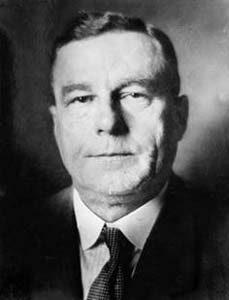Mr George Lionel Macandie

George Lionel Macandie (1877-1968), public servant and naval administrator, was born on 26 June 1877 at South Brisbane, fifth child of Scottish parents William Macandie, clerk, and his wife Catherine, née Kennedy. He was educated at Brisbane Grammar School and qualified as an Associate of the Federal Institute of Accountants on 29 April 1903. On 18 August 1896 he had joined the Queensland Public Service as a clerk in the Maritime Defence Force Office.
After Federation Macandie transferred to the Commonwealth Department of Defence and in 1903 joined Captain (Sir) William Creswell [q.v.] in setting up the Navy Office in Melbourne. On 24 February 1904, at Park Church, South Brisbane, he married Alice Hood with Presbyterian forms; they had three children. He served with Creswell as a senior clerk through the wilderness years while Australia sought to establish a firm naval policy, and he rejoiced in 1909 at the decision to create a substantial fleet. He laboured on the development and administration of the RAN, playing his part backstage; he controlled the office, conducted correspondence, devised and watched over systems for administering the fleet; in short he was an enabler-advising and guiding the Navy on how best to achieve its manifold aims. He was Secretary of the Australian Naval Board, holding this post from 1914 to 1946. He was given honorary rank-Paymaster in 1912 and Fleet Paymaster (equivalent to commander) in 1916.
Macandie was the Secretary of the first Department of the Navy from March 1919 until the Navy Office was again merged into the Department of Defence in 1921. After having received some criticism from a 1918 Royal Commission on Deficiencies in Naval Administration he was belatedly accorded the benefit of a years experience at the British Admiralty from June 1920 - while surviving attempts by lesser men to oust him from office. In October 1920 he was appointed CBE for his wartime services. He guided the RAN through the financial reductions of the 1920s and 1930s and saw the brief revival of naval aspirations under the Bruce-Page government with the acquisition of HMA Ships Australia and Canberra in 1928-29. He was one of the unseen architects of the naval part of the defence development programme of the mid-1930s, when Sydney, Perth and Hobart were added to the fleet. He assisted a succession of naval leaders from the RN until RAN officers acquired necessary experience and seniority.
When, by 1941, World War II brought again the need for a separate department to administer the Navy, Macandie was 64 and the government wanted a younger man at the helm. AR Nankervis [q.v.], who was appointed Secretary, was well served by Macandie as Secretary of the Naval Board. He remained until May 1946, beyond his formal retirement from the public service in June 1942. Subsequently he complied The Genesis of the Royal Australian Navy, published in 1950.
Macandie's private interests were dominated by his Presbyterianism; he was an Elder of the Frank Paton Memorial Church, Deepdene, Melbourne, its Session Clerk in 1923-34 and Superintendent of its Sunday school in 1935-39. Survived by his wife, son and two daughters, he died at Canterbury on 30 April 1968 and was cremated. He was a large likeable man, calm in a crisis, with a controlled geniality and a sometimes impish sense of humour. If Creswell [q.v.] was the father of the RAN, Macandie was its benign and watchful uncle.
Robert Hyslop


